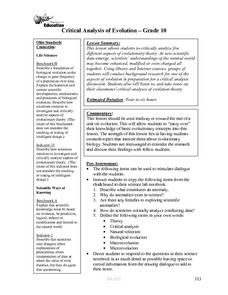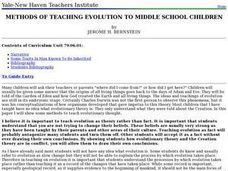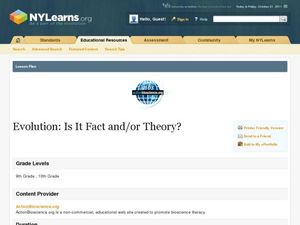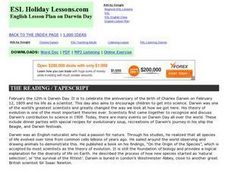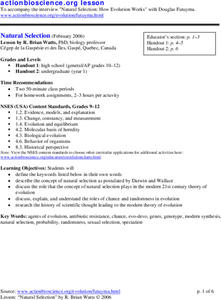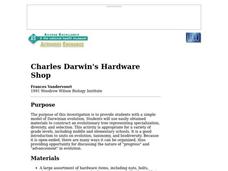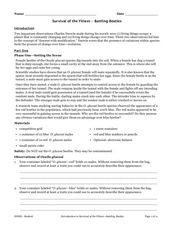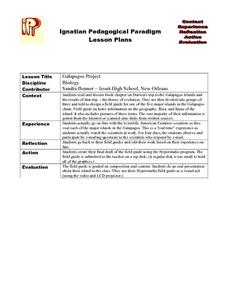Curated OER
A Model for Natural Selection- Spaghetti Worms
Does the early bird really get the worm? If so, which color of worm does it prefer? In an exciting and easy week-long field investigation, young field biologists set up a one square meter feeding area for birds. If you have a webcam,...
Curated OER
Critical Analysis of Evolution
Tenth graders discuss anomalies in nature and science. They discuss times that anomalies led to the collection of data that explained the phenomena and contributed to changing scientific understandings. Students work in groups to...
Curated OER
Evolution
Pupils create a timeline on the history of evolution. In this biology lesson, students research their assigned scientist's contribution to evolution theory. They write a three-paragraph analysis about the timeline.
Curated OER
Methods of Teaching Evolution To Middle School Children
Learners study evolutionary thought. They examine how characteristics are inherited and that they are a source of variation. They illustrate the perpetuation, elimination, and variation made among members of a species. They determine...
Curated OER
Is Evolution Just Monkey Business?
Learners examine the presentation of the theory of evolution in the science classroom. They define and discuss aspects of evolution, evaluate the presentation of evolutionary theory, and write a persuasive essay.
Curated OER
Evolution: Is It Fact and/or Theory?
Students explore the concepts of evolution. In this biology lesson, students read articles from the internet. They discuss the article within the group and answer their handouts.
Curated OER
Our Universe: Designed or Evolved?
Students brainstorm and write arguments for Evolution and Intelligent Design. They research the history of each of these ideas. They also examine the controversy of teaching one or both ideas in schools.
Curated OER
The "Science" of Racism
How can we keep racism out of our society? Analyze the factors that lead to racism today and research previous scientific findings that impacted social policy. Your high school students identify ways to prevent past mistakes from...
Curated OER
Darwin Day
In this Darwin Day worksheet, students read or listen to a tape passage about Charles Darwin, then match phrases, fill in the blanks, choose words, unscramble words and sentences, put sentences in order, write discussion questions and...
ARKive
Galapagos Conservation
The Galapagos Islands inspired Darwin to develop his theory of evolution. These wonderful islands will also be the topic of a lesson on habitat and conservation. In small groups, learners will collect and synthesize information regarding...
Curated OER
Artificial Selection
The second lesson in the series begins with a starter activity discussing wild versus domesticated animals. Then, scholars play a card game, with optional variations, to emphasize artificial selection. Next, they attend a field trip to a...
Curated OER
Birds of a Feather Flock to the Web
Students define the term "evolution" and relate it to species adaptation, supporting their ideas with examples. They locate, correctly cite, and briefly review two Web sites with information on finches commonly found in their state or count
Curated OER
Natural Selection
Students use discussion questions, handout information and research topics to explore several issues related to natural selection and evolution. They examine Darwin's research on the finch and antibiotic resistance.
Curated OER
Populations – The Survival of the Fittest (Part 1)
Pupils explain in their own words why organisms live together. In this biology lesson, students model what happens to organisms if their environment changes. They explain the importance of evolution.
Curated OER
Introduction to Biology
Students examine the principles of natural selection and explain how it is the basis of the theory of evolution. In this natural selection lesson students research the web on the theory of evolution.
Curated OER
Physiological Adaptations
Students investigate the concepts of genetics and how it is tied to the variations found within different species and how it is tied to adaptations. They review the theory of evolution and factors found to help create variation. The...
Curated OER
Charles Darwin's Hardware Shop
Students construct an evolutionary tree representing specialization, diversity, and selection using easily obtained materials. They use at least twenty pieces of hardware to classify then develop "evolutionary" relationships between the...
Curated OER
Survival of the Fittest -- Battling Beetles
Learners experiment with traits. In this Science lesson plan, students test the strength of beetles using M&M candies in lieu of the insects. Learners use the Hardy-Weinberg Equation to calculate possible offspring traits of further...
Curated OER
Natural Selection.... a Cumulative Process... it's in the cards!
Students working in pairs attempt to produce a full sequence of 13 cards of one suit (ace - to king). This must be done by shuffling the suit of cards for each round, then checking the cards.
Curated OER
Survival of the Fittest – Battling Beetles
Young scholars explore natural selection. For this genetic adaptation lesson, students discover why certain traits continue and some traits disappear. Young scholars discover how species evolve and change. Resources are provided.
Curated OER
"Intelligent Design" and Ohio's Science Curriculum
Students explore the debate between intelligent design and Darwinism. They research both topics by accessing primary sources. Students interview school administrators to determine what its science curriculum is and the timeline for any...
Curated OER
Galapagos Project
Students explore Darwin's trip to the Galapagos Islands. In groups, students create a field guide for one of the five major islands in the Galapagos.
Curated OER
A Mendel Seminar
High schoolers analyze Gregor Mendel's discovery of a process of biological evolution. They also explore how recessive and dominant traits are passed from one generation of living organisms to the next. This lesson involves environment...
Curated OER
Lamarck Is Dead!
Students read Lamarck's obituary and respond to questions. They discuss the four laws from Lamarack's studies. Students apply this information to scientific theories in general.



